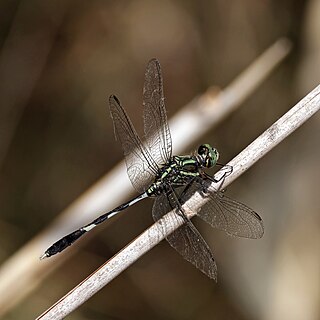
Orthetrum sabina, the slender skimmer or green marsh hawk, is a species of dragonfly in the family Libellulidae. It is widespread, being found from south-eastern Europe and North Africa to Japan and south to Australia and Micronesia.

Trithemis aurora, the crimson marsh glider, is a species of dragonfly in the family Libellulidae. It is a common and widely distributed species found throughout the year across the Indian subcontinent and Southeast Asia.

Esme longistyla is damselfly in the family Platycnemididae. It is commonly known as the Nilgiri bambootail. It is endemic to Western Ghats in India.
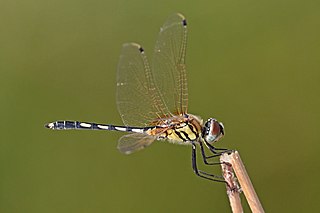
The long-legged marsh glider or dancing dropwing is a species of dragonfly found in Asia.

Lestes elatus is a species of damselfly in the family Lestidae, the spreadwings. It is known commonly as the emerald spreadwing. It is native to India, Thailand and Sri Lanka.

Heliocypha bisignata, stream ruby, is a species of damselfly in the family Chlorocyphidae. It is endemic to South India where it breeds in hill streams in the southern part of the country.
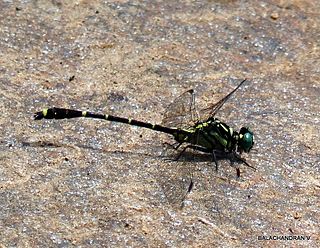
Burmagomphus laidlawi is a species of dragonfly in the family Gomphidae. It is known only from the high altitude regions of Western Ghats of India.
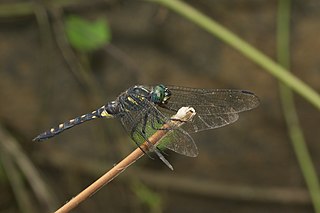
Onychothemis testacea, Stellate river hawk, riverhawker, is a species of dragonfly in the family Libellulidae. It is widespread in many Asian countries.

Agriocnemis splendidissima, the splendid dartlet, is a species of damselfly in the family Coenagrionidae. It is distributed throughout India and Pakistan and may be present in Bangladesh as well.

Dysphaea ethela, black torrent dart, is a species of damselfly in the family Euphaeidae. The insect is named after Frederic Charles Fraser's wife, Ethel Grace Fraser (1881-1960), a constant companion of his collecting trips in India.

Euphaea cardinalis, Travancore torrent dart, is a species of damselfly in the family Euphaeidae.

Euphaea dispar, Nilgiri torrent dart, is a species of damselfly in the family Euphaeidae.

Euphaea fraseri, Malabar torrent dart, is a species of damselfly in the family Euphaeidae. This species is endemic to the Western Ghats; known to occur in various locations up to Goa.

Caconeura ramburi is a damselfly species in the family Platycnemididae. It is commonly known as the Coorg Bambootail or Indian blue bambootail. It is endemic to Western Ghats.

Disparoneura quadrimaculata, black-winged bambootail is a damselfly species in the family Platycnemididae. It is a widely distributed species in India.

Elattoneura souteri is a damselfly species in the family Platycnemididae. It is endemic to Western Ghats in India.

Phylloneura westermanni, Myristica bambootail is a damselfly species in the family Platycnemididae. It is endemic to Myristica swamps of Western Ghats in India. The habitat is restricted to a few localities in Karnataka, Kerala and Tamil Nadu.

Indosticta deccanensis, saffron reedtail is a damselfly species in the family Platystictidae. It is endemic to Western Ghats in India.
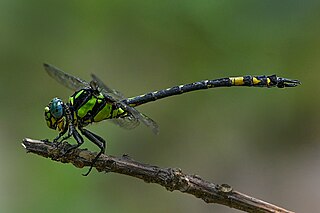
Megalogomphus hannyngtoni, is a species of dragonfly in the family Gomphidae. It is known only from the Western Ghats of India.

Megalogomphus superbus, is a species of dragonfly in the family Gomphidae. It is known only from the Western Ghats of India.






















